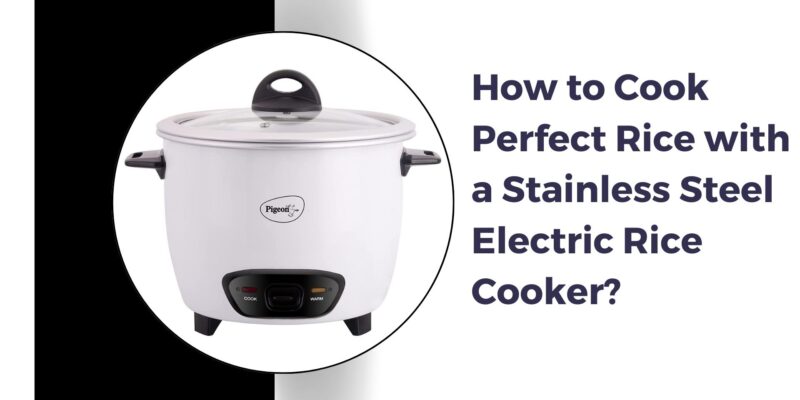
A stainless steel electric rice cooker is a kitchen appliance designed specifically for cooking rice. Unlike traditional methods that require constant attention, an electric rice cooker automates the process, ensuring perfectly cooked rice with minimal effort. The stainless steel interior is durable, easy to clean, and free from harmful chemicals, making it a safe and healthy choice for your kitchen.
Why Choose a Stainless Steel Electric Rice Cooker?
- Durability: Stainless Steel Electric Rice Cooker is highly durable and can withstand high temperatures without getting damaged.
- Health Benefits: Unlike non-stick coatings, stainless steel does not release harmful chemicals into your food.
- Easy to Clean: Stainless steel is easy to clean and resistant to stains and odors.
- Consistent Results: Electric rice cookers provide consistent results every time, reducing the chances of undercooked or overcooked rice.
Getting Started with Your Stainless Steel Electric Rice Cooker
Unpacking and Setting Up
When you first get your rice cooker, unpack it carefully and read the user manual. This will give you important information about how to use and maintain your appliance.
- Wash the Inner Pot: Before using your rice cooker for the first time, wash the stainless steel inner pot with warm soapy water and dry it thoroughly.
- Assemble the Parts: Make sure all parts are correctly assembled, including the lid, inner pot, and any accessories.
- Place the Cooker on a Stable Surface: Find a stable, flat surface in your kitchen to place your rice cooker. Ensure there is enough space around it for ventilation.
Understanding the Controls
Modern electric rice cookers come with various settings and controls. Familiarize yourself with these controls to make the most of your appliance.
- Basic Settings: Most rice cookers have basic settings like “Cook” and “Warm”. The “Cook” setting starts the cooking process, and the “Warm” setting keeps the rice warm after it’s cooked.
- Advanced Settings: Some models offer additional settings for different types of rice (e.g., white rice, brown rice) or cooking methods (e.g., steaming, slow cooking).
Measuring Rice and Water
The Right Rice-to-Water Ratio
Getting the right rice-to-water ratio is crucial for cooking perfect rice. Here are some general guidelines:
- White Rice: For every cup of white rice, use 1.5 to 2 cups of water.
- Brown Rice: For every cup of brown rice, use 2 to 2.5 cups of water.
- Jasmine or Basmati Rice: For these types of rice, use 1.25 to 1.5 cups of water per cup of rice.
Using the Measuring Cup
Many rice cookers come with a special measuring cup. Use this cup for measuring rice and water to ensure accuracy.
- Measure the Rice: Use the measuring cup to scoop the desired amount of rice. Level off the top for an accurate measurement.
- Rinse the Rice: Rinse the rice under cold water until the water runs clear. This removes excess starch and prevents the rice from becoming too sticky.
- Add Water: Place the rinsed rice into the inner pot and add the appropriate amount of water using the same measuring cup.

Cooking the Rice
Starting the Cooking Process
- Close the Lid: Make sure the lid is securely closed to trap the steam inside.
- Select the Right Setting: Choose the appropriate setting for the type of rice you are cooking.
- Press Start: Press the “Cook” button to start the cooking process. The rice cooker will automatically switch to “Warm” mode once the rice is done.
Monitoring the Cooking
While the rice cooker does most of the work for you, it’s still good to monitor the process occasionally.
- Avoid Opening the Lid: Do not open the lid during cooking, as this releases steam and can affect the cooking process.
- Check the Indicators: Most rice cookers have indicator lights or sounds to let you know when the rice is ready.
Finishing Touches
Letting the Rice Sit
Once the rice cooker switches to “Warm” mode, let the rice sit for about 10 minutes. This allows the moisture to evenly distribute throughout the rice, making it fluffier.
Fluffing the Rice
Use a rice paddle or a fork to gently fluff the rice. This helps release any remaining steam and separates the grains.
Advanced Tips for Perfect Rice
Adding Flavor
Enhance the flavor of your rice by adding a few ingredients before cooking:
- Broth Instead of Water: Use chicken, beef, or vegetable broth instead of water for a richer flavor.
- Aromatics: Add a bay leaf, a few cloves of garlic, or a piece of ginger to the rice for added aroma and taste.
- Seasonings: A pinch of salt, a knob of butter, or a splash of olive oil can also enhance the flavor.
Cooking Different Types of Rice
Different types of rice require different cooking methods. Here are some tips for cooking various types of rice in your electric rice cooker:
- Brown Rice: Brown rice takes longer to cook and requires more water. Use the brown rice setting if your cooker has one.
- Sushi Rice: Sushi rice should be rinsed thoroughly and cooked with a 1:1 ratio of rice to water. Once cooked, season with rice vinegar, sugar, and salt.
- Wild Rice: Wild rice has a tough outer shell and needs more water and time to cook. Use 3 cups of water for every cup of wild rice.
Preventing Common Problems
- Sticky Rice: If your rice is too sticky, try rinsing it more thoroughly before cooking. Using a bit less water can also help.
- Dry or Undercooked Rice: If the rice is dry or undercooked, add a little more water and cook for a few more minutes.
- Burnt Bottom Layer: To prevent the bottom layer from burning, stir the rice once during the cooking process if your rice cooker allows it.
Cleaning and Maintenance
Cleaning the Rice Cooker
- Unplug the Cooker: Always unplug the rice cooker and let it cool before cleaning.
- Remove the Inner Pot: Take out the stainless steel inner pot and wash it with warm soapy water. Use a soft sponge to avoid scratching the surface.
- Wipe the Exterior: Use a damp cloth to wipe the exterior of the rice cooker. Avoid using abrasive cleaners.
Regular Maintenance
- Check the Seal: Ensure the seal on the lid is clean and intact. Replace it if it shows signs of wear.
- Inspect the Cord: Regularly check the power cord for any signs of damage.
- Store Properly: Store your rice cooker in a cool, dry place when not in use.
Conclusion
Cooking perfect rice with a stainless steel electric rice cooker is easy once you know the basics. By following the steps outlined in this guide, you can enjoy fluffy, delicious rice every time. Remember to measure your rice and water accurately, use the right settings, and add your own touch with flavors and seasonings. With a little practice, your rice cooker will become an indispensable tool in your kitchen, helping you create tasty meals with minimal effort.
FAQs
Can I Cook Other Grains in My Rice Cooker?
Yes, you can cook other grains like quinoa, barley, and oats in your rice cooker. Follow the same principles, adjusting the water ratio and cooking time as needed.
How Long Does It Take to Cook Rice?
The cooking time varies depending on the type of rice. White rice typically takes 20-30 minutes, while brown rice can take 40-50 minutes.
Why Is My Rice Cooker Leaking?
Leaking can occur if there is too much water or if the lid is not properly sealed. Ensure you are using the correct rice-to-water ratio and that the lid is securely closed.
Can I Reheat Rice in My Rice Cooker?
Yes, you can reheat rice in your rice cooker. Use the “Warm” setting to gently heat the rice without drying it out. Add a splash of water if needed to keep the rice moist.
By mastering the use of your stainless steel electric rice cooker, you can simplify your cooking routine and consistently enjoy perfect rice. Happy cooking!
For more insightful articles related to this topic, feel free to visit Emperiortech










